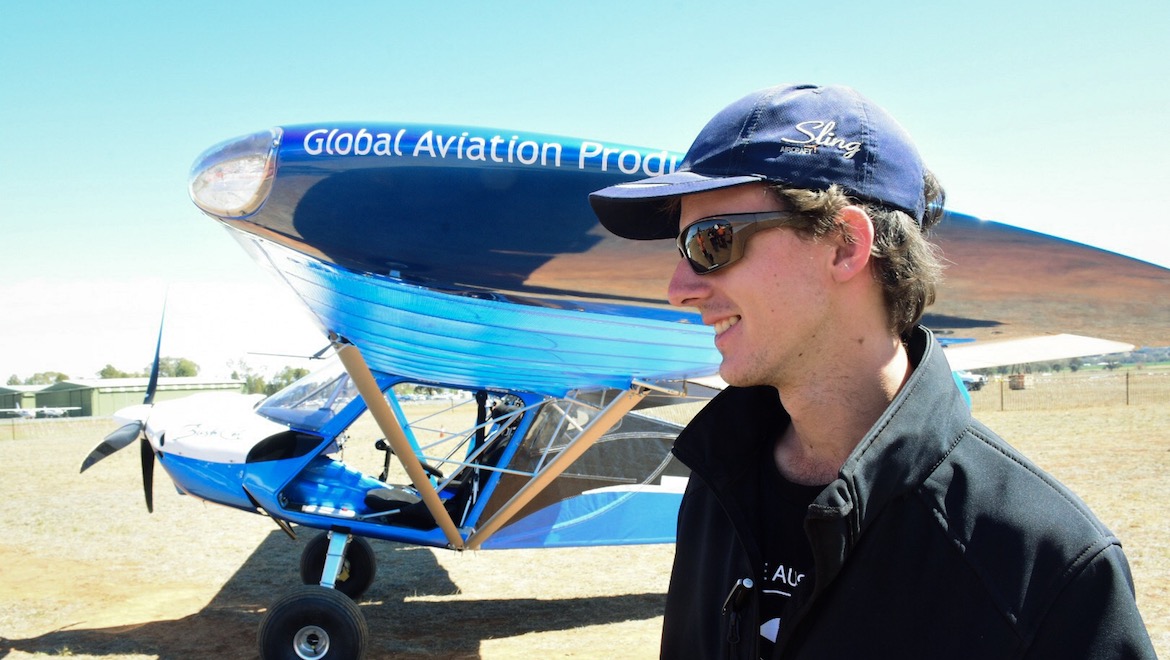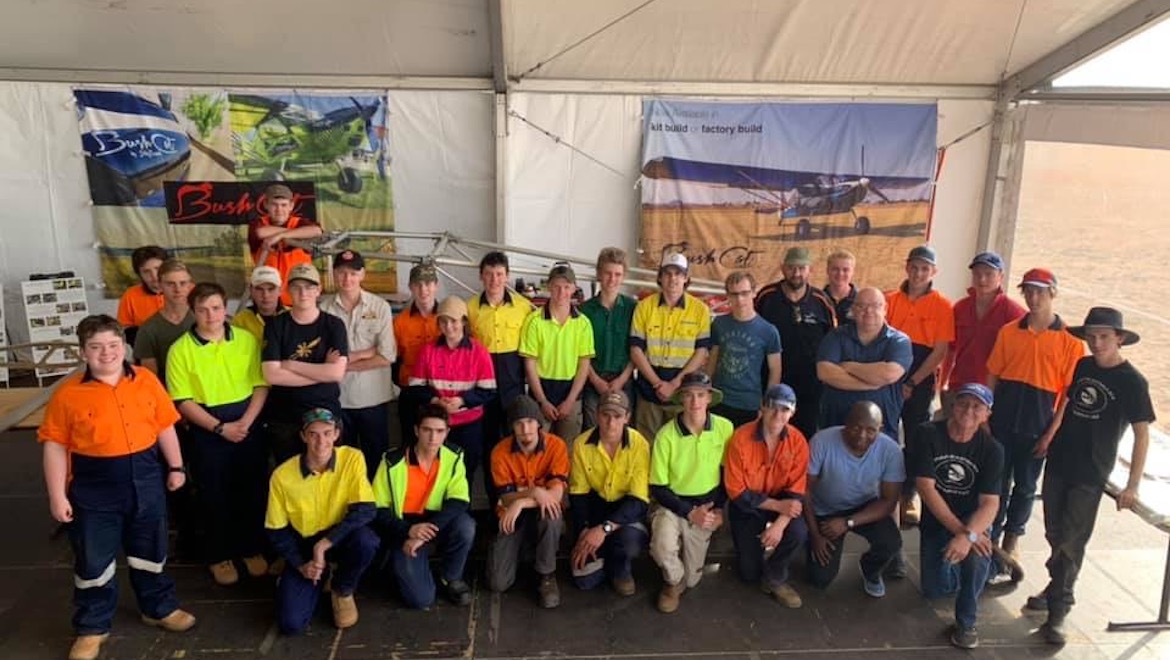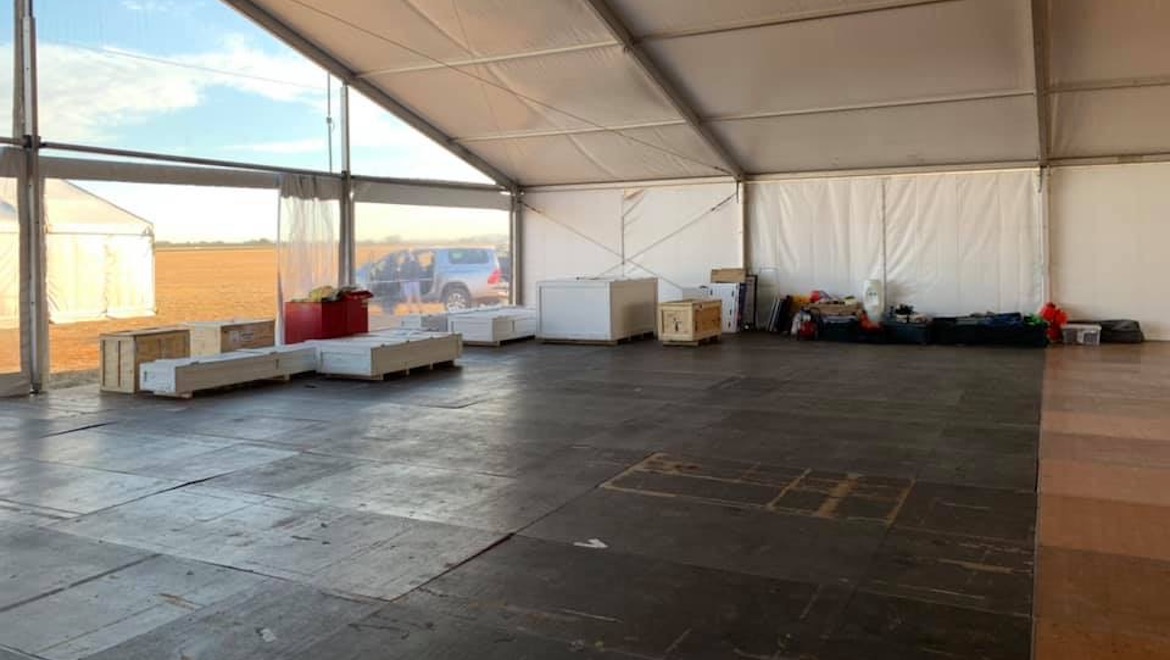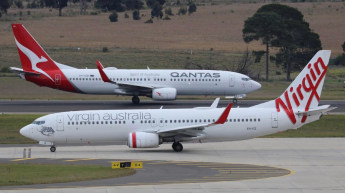
As test pilot James Weightman taxied the blue and black light-sport aircraft onto Runway 22 at Parkes Regional Airport, spectators watched on befuddled as a large group of students in high-vis shirts ran towards the runway with red dust trailing behind them.
Wiping his sweaty palms across dirty jeans one more time, Weightman radioed the control tower for runway clearance before opening the throttle to full power.
BushCat 2209 effortlessly lifted off the runway – a mission accomplished for the 25 students whose efforts over the previous week had led to this moment on Sunday, September 22 2019.
TWENTY-FIVE KIDS, SEVEN DAYS, ONE LIGHT-SPORT AIRCRAFT
AirVenture Australia is not just an airshow. The event, held annually, also aims to showcase different pathways into aviation such as gliding, maintenance, building, buying and flying.
Parkes was the fifth airshow AirVenture Australia has hosted and the program had everything from building and selling aircraft to flight displays from Red Bull Air Race world champion Matt Hall.
In the lead up to the event, organisers put out a call to high schools and career programs for students interested in building a BushCat aircraft from a kit.
From the many applications received, 24 boys and one girl were selected. The group, aged between 15 and 18, included students from the surrounding Parkes region as well as interstate.
Some of the students had already completed a significant amount of their flying training, while others were still aiming for the skies or happy to be the brains on the ground.
The group was supervised by five experienced aviators and builders.

The fastest recorded time a BushCat had ever been built was in Australia by Global Aviation Products owner Errol van Rensburg and test pilot Weightman at the 2017 Narromine airshow, when the pair put together the aircraft in 21 days for an exhibition.
On this occasion, the challenge was to build the aircraft in seven days.
BushCat South Africa chief executive Mike Gill said the seven-day challenge had been on his mind for a while. To that end, the company had over the past year made significant improvements to its packing methods, as well as packing lists and manuals, to speed up the construction process.
At the same time, AirVenture Australia had also been discussing a similar challenge, leading the two to partner together for the initiative to be part of the Youth Aviation Careers and STEM Exposition – which works to involve students in interactive and educational aviation-based programs at the Parkes airshow.
AirVenture Australia director David Young said getting students to attempt the challenge was the ideal way to get young people exposed to the aviation industry as it represented tangible, “hands-on” engagement.
“The whole thing became very real when we spoke to Errol, because the BushCat is an aircraft that can be built in a relatively short period of time, verses other kit-built aeroplanes,” Young said.

ENCOURAGING EARLY SIGNS
The BushCat arrived in seven crates on the back of a trailer at Parkes Regional Airport on Monday September 16, waiting to be opened and unpacked by the 25 eager students. The manual, presented in an informative, easy-to-follow layout, stated the aircraft would normally take about 250 hours to complete.
When Gill and BushCat assembly manager John Mabunda turned up late on Monday afternoon, the pair expected the students to have only completed inventory at most.
However, what the two men saw was that four hours into the build, the main empennage and wing structures had already been assembled.
“The first part of the build does go reasonably quick, it should slow down for the rest of the week, but after seeing the enthusiasm of the kids and their teamwork, I’m looking forward to seeing this completed within seven days,” Gill said after observing the students at work on the first day.
The early indications were that the 25 students and five supervisors were likely to succeed, given the aircraft was covered in its “skins” and standing on its wheels by day two.
Errol van Rensburg said he always knew it was absolutely possible to build the aircraft in a week. He believed enthusiasm, supervision and quality represented a “good recipe” for success in an educational program.
“Some of the kids were so excited and focused, I had to force them to stop and take a break, they weren’t interested in their lunch, they were interested in the build,” van Rensburg said.
“We also had excellent supervision. All the supervisors were experienced aviators, builders and inspectors, there were a lot of safety precautions set in place to ensure the quality and safety of this build.”

Among the five supervisors was Darren Barnfield from the Civil Aviation Safety Authority (CASA), who inspected and approved the aircraft for its maiden flight.
Barnfield, who worked with the students throughout the week, said he was surprised at the level of enthusiasm and teamwork displayed from the very beginning. He credited much of the success of the build to the quality and integrity of the BushCat kit.
“The kit, plans and construction are set out in a way that you can’t get ahead of yourself,” Barnfield said.
“It allowed the kids to correctly follow the instructions down to the [last] bolt and screw.”
Mabunda, who has built about 150 BushCat aircraft with his team in South Africa, was another impressed supervisor.
“I was happy to see their production with so little experience,” Mabunda said on the first day. “They made my job easy.”
The atmosphere in the workshop was electric, with the sound of excited chatter, banging tools and blaring country music a constant throughout the week.
And the students, most of whom had never met each other before, became fast friends as they worked, danced and joked together with the progression of the aircraft’s assembly.
One of the students that worked mainly on the left wing section was 17-year-old Timothy Gellert from Yeoval in New South Wales.
Gellert said his family was incredibly supportive of him being part of the challenge, with his father driving him an hour to and from the build each day.
“My mom’s dad flew for the Mission Aviation Fellowship, so she was excited almost more excited than I was,” Gellert said.
“My dad isn’t into flying, but he’s into mechanical stuff, so every day after the build we’d be talking about the engine or the wings.”
On the last day, Gellert showered and dressed at the airport to attend his year 12 ball, not wanting to miss a single minute of the experience. He said hoped to fly for the Royal Australian Air Force (RAAF), or for the Mission Aviation Fellowship like his grandfather, once he completed his schooling.
Another of the students, 18-year-old Ethan Pay, was currently completing his last week of high school in Parkes. Pay hoped to study mechanical engineering at university in Sydney or in Newcastle.
In the past, he was part of a team of students who built a glider over five months for the Moomba Bird Man Rally in Victoria.
“I’ve never wanted to work as much as I have for this build,” Pay said.
“I’ve had so much fun here, just learning to work in a team, making sure my workmanship is to a certain standard.
“We want to finish with a quality product, so I really want people to know how much effort was put into this build.”

TO THE RUNWAY
Once the aircraft was completed, the students and their parents watched along the sidelines as the blue and black light-sport aircraft taxied toward the runway before lifting into the air during a break in the airshow’s flight displays.
The air was tense as the aircraft turned into the circuit to fly around the airport. Waiting with sweaty palms and nervous chatter, students watched as test pilot Weightman turned back to the field before breaking into a resounding cheer as the wheels kissed the tarmac upon landing.
“It’s crazy to think the whole [aircraft] was in boxes six days ago,” student Alex Smythe said as Weightman taxied the aircraft back around the main tent.
The emotion and relief of the successful flight was not only clear among the students, but definitely among the five supervisors as well.
Gill said he had wondered whether the aircraft would be ready to fly on Sunday September 22, following minor technical concerns on the Saturday night.
“I was very relieved [when the aircraft landed after its test flight],” Gill said.
“I was worried it wouldn’t happen, but I knew we had the right people to sort out the technical issues so we could fly.”
[vc_gallery interval=”0″ images=”78341,78342,78343,78348,78344,78350,78349″ img_size=”750×420″ title=”Scenes from the BushCat build (Images by Marena Janse van Rensburg)”]
van Rensburg, whose Global Aviation Products company is the official distributor of the BushCat in Australia, added: “I get a bit emotional thinking about it. This was probably one of the best weeks of my life, we [supervisors] were so lucky to have worked with these kids on such an amazing kit.”
The camaraderie among the students was evident with their reluctance to leave after the show, choosing instead to hang around the team and enjoy some of the flight displays from their seats in the cockpit and on the wheels.
The aircraft will be given away to one lucky person who attended the airshow after it had completed 25 hours of test flying.
Perhaps the success of this seven-day build will not only speak for the quality and ease of the BushCat kit, but will open the minds of these youth to the world of aviation, instilling in them the passion that is taking to the skies.
VIDEO: Highlights of the 2019 AirVenture Australia event at Parkes Regional Airport from the Freddie Howard YouTube channel.
Marena Janse van Rensburg is the daughter of Global Aviation Products owner Errol van Rensburg.














William GOODE
says:Wow that’s fantastic team, NRAC is thinking of getting into STOL too, maybe a Savannah.
William GOODE
says:STOL is in the news with the 42-600, possibly for REX, but why raffle it off to some random, that’s sooo Australian and not really a business model, if its such a success, and a kit with good instructions and packaging is a start why stop at one, we honestly need a fleet, the Jabirus are not enough on their own.